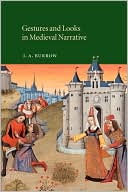

 |

|

The average rating for Gestures and Looks in Medieval Narrative based on 2 reviews is 3.5 stars.
Review # 1 was written on 2019-10-23 00:00:00 Travis Bayes Travis BayesWeak four stars. I read this because I was very impressed with WI's treatment of Sophocles' Ajax in an article that focused on the kommos and climactic agon. This is much less controversial (WI was strangely contemptuous of Teucer and his manners but nothing here really matches that): his main contention is that Aeschylus' archaic poetry (a slightly un-nuanced understanding of 'archaic' considering that his mysteriousness is more like a contemporary Pindar than a lot of older poets like Solon, Hesiod, Theognis, Anacreon, you get the picture) is primarily interested in religion (fine). Ancillary to this is a keen interest in how Aechylus' other plays including the Prometheus Desmotes of dubious authorship might have fit into the trilogy format. Conjectures on lost drama tends to lead to a lot of circularity and ultimately imprecise conjecture (c.f. Hutchinson's dismantling of the old dogma regarding Euripides' first Hippolytus) but we are on safer ground in Aeschylus' trilogies which tended to make a full treatment of a saga of myth (the series of revenge-murders in the House of Atreus following Agamemnon's return, the Danaids past their unhappy union with Aegyptii up to their second, successful marriage, etc.). WI's reconstruction of Aeschylus' Theban trilogy ends up looking very messy (is it plausible that Aeschylus just decided to go HAM with mythological detail and creates this full but amorphous and ineffectual account or as in the more substantial Danaid trilogy or the Orestaea, did he come up with something more structured and effective?) and ultimately, even with a greater certainty of the shape and form of these lost plays, I don't think WI has come up with something of real heuristic significance here although his estimations are sometimes quite interesting. As a result of this, WI's strongest articles are on the Orestaea, whose trilogic form survives completely, and these focus on issues of religious belief and character. I found his treatment of the character of Clytemnestra particularly cogent, probably the best article of the lot; his article on Agamemnon's character ultimately makes a bit too little of an admittedly impossible issue. |
Review # 2 was written on 2014-12-26 00:00:00 Demetre Kirizopoulos Demetre KirizopoulosIt's medieval France, a time before TV, movies, sports. What did one do for entertainment? Tell stories of course! Bards and entertainers traveled the courts plying their trade, and in the 1200's the story of the Holy Grail was one of the favourites. Each one took the basic pagan tale, Christianized it of course, and made it his own, changing it freely to suit his audience. Several have passed down to us in written form, and the author attempts here to trace the connections back to the pagan tales for each. For example, the bloody spear which pierced the Lord perhaps arose from a spear that paralyzed an Irish chieftain which appears in older Irish stories. The name Pelles could be a derivation of the Welsh king Beli. That sort of thing. It is one historian's opinion of course, and I'm certain other equally scholarly types would disagree with certain points. But it is an interesting read, weaving the actual text with the analysis. Recommend it. |
CAN'T FIND WHAT YOU'RE LOOKING FOR? CLICK HERE!!!